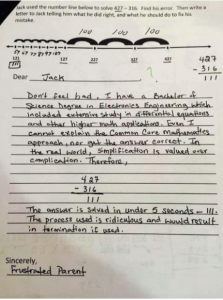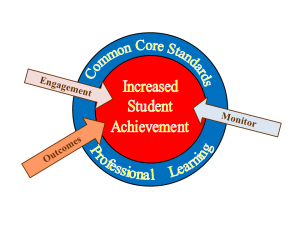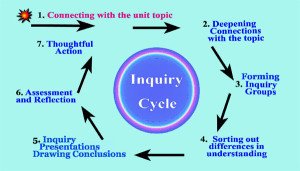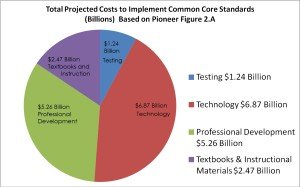Common Core Articles
WHEN THE CIRCUS DESCENDS
By David Brooks 4/17/2014
We are pretty familiar with this story: A perfectly sensible if slightly boring idea is walking down the street. Suddenly, the ideological circus descends, burying the sensible idea in hysterical claims and fevered accusations. The idea’s political backers beat a craven retreat. The idea dies.
 This is what seems to be happening to the Common Core education standards, which are being attacked on the right because they are common and on the left because they are core.
This is what seems to be happening to the Common Core education standards, which are being attacked on the right because they are common and on the left because they are core.
About seven years ago, it was widely acknowledged that state education standards were a complete mess. Huge numbers of students were graduating from high school unprepared either for college work or modern employment. A student who was rated “proficient” in one state would be rated “below basic” in another. About 14 states had pretty good standards, according to studies at the time, but the rest had standards that were verbose, lax or wildly confusing.
The National Governors Association and the Council of Chief State School Officers set out to draft clearer, consistent and more rigorous standards. Remember, school standards are not curricula. They do not determine what students read or how teachers should teach. They are the goals for what students should know at the end of each grade.
This was a state-led effort, supported by employers and financed by private foundations. This was not a federal effort, though the Obama administration did encourage states to embrace the new standards.
These Common Core standards are at least partially in place in 45 states. As is usual, the initial implementation has been a bit bumpy. It’s going to take a few years before there are textbooks and tests that are truly aligned with the new standards.
 But the new initiative is clearly superior to the old mess. The math standards are more in line with the standards found in the top performing math nations. The English standards encourage reading comprehension. Whereas the old standards frequently encouraged students to read a book and then go off and write a response to it, the new standards encourage them to go back to the text and pick out specific passages for study and as evidence.
But the new initiative is clearly superior to the old mess. The math standards are more in line with the standards found in the top performing math nations. The English standards encourage reading comprehension. Whereas the old standards frequently encouraged students to read a book and then go off and write a response to it, the new standards encourage them to go back to the text and pick out specific passages for study and as evidence.
The Thomas B. Fordham Institute, which has been evaluating state standards for more than 15 years, concluded that the Common Core standards are “clearly superior” to the old standards in 37 states and are “too close to call” in 11 more.
But this makes no difference when the circus comes to town.
On the right, the market-share-obsessed talk-radio crowd claims that the Common Core standards represent a federal takeover of the schools. This is clearly false. This was a state-led effort, and localities preserve their control over what exactly is taught and how it is taught. Glenn Beck claims that Common Core represents “leftist indoctrination” of the young. On Fox, Elisabeth Hasselbeck cited a curriculum item that supposedly taught students that Abraham Lincoln’s religion was “liberal.” But, as the education analyst Michael J. Petrilli quickly demonstrated, this was some locally generated curriculum that was one of hundreds on a lesson-sharing website and it was promulgated a year before the Common Core standards even existed.
As it’s being attacked by the talk-radio right, the Common Core is being attacked by the interest group left. The general critique from progressives, and increasingly from teachers’ unions, is that the standards are too difficult, that implementation is shambolic and teachers are being forced into some top-down straitjacket that they detest.
It is true that the new standards are more rigorous than the old, and that in some cases students have to perform certain math skills a year earlier than they formerly had to learn them. But that is a feature, not a bug. The point is to get students competitive with their international peers.
The idea that the Common Core is unpopular is also false. Teachers and local authorities still have control of what they teach and how they teach it. A large survey in Kentucky revealed that 77 percent of teachers are enthusiastic about the challenge of implementing the standards in their classrooms. In another survey, a majority of teachers in Tennessee believe that implementation of the standards has begun positively. Al Baker of The Times interviewed a range of teachers in New York and reported, “most said their students were doing higher-quality work than they had ever seen, and were talking aloud more often.” 
The new standards won’t revolutionize education. It’s not enough to set goals; you have to figure out how to meet them. But they are a step forward. Yet now states from New York to Oklahoma are thinking of rolling them back. This ha
The new standards won’t revolutionize education. It’s not enough to set goals; you have to figure out how to meet them. But they are a step forward. Yet now states from New York to Oklahoma are thinking of rolling them back. This has less to do with substance and more to do with talk-radio bombast and interest group resistance to change.
The circus has come to town.
WHY IS THIS COMMON CORE MATH PROBLEM SO HARD? SUPPORTERS RESPOND TO QUIZ THAT WENT VIRAL
Hechinger Report 3/26/2014
It may be the first time a math problem has gone viral on the Internet.
A frustrated father posted a subtraction problem from his second-grade son’s math quiz on Facebook this week with a note to the teacher calling it ridiculous. Conservative pundits, including Glenn Beck, seized on it as evidence that the new standards are nonsensical and “stupid,” adding more fuel to the backlash against the Common Core as it rolls out in schools across the country.
(Photo: Facebook/The Patriot Post)
The problem asks how Jack, a fictional student, miscalculated when he used a number line to find the answer to the subtraction problem 427 – 316. Students are then asked to write a letter to Jack explaining what he did right and what he did wrong.
Critics say the problem takes a simple one-step subtraction problem and turns it into a complex endeavor with a series of unnecessary steps, including counting by 10s and 100s. The father, Jeff Severt, who has a bachelor’s in engineering, told Beck the problem was particularly difficult for his son, who has autism and attention disorders and trouble with language arts. He said that after spending two frustrating hours going over the earlier pages of his son’s math quiz, he was stumped by the problem himself.
So why is the problem so difficult? The Hechinger Report asked a couple of the lead writers of the Common Core math standards, Jason Zimba and William McCallum.
Their response? Don’t blame Common Core. Blame a poorly written curriculum.
“That question would not be in a textbook if I wrote it,” Zimba said.
McCallum, math department chair at the University of Arizona, had some of the same concerns about the problem as the conservative critics.
“It’s a complete reversal of the truth to call this a Common Core problem,” he said. What Common Core actually requires, McCallum argues, is fluency in the simple skills of adding and subtracting that critics are calling for. “Complaining that this is a Common Core method, when the Common Core doesn’t require this method, but does require the method he wants, it’s just a lie,” he added.
The question appears to be aiming for several of the main Common Core math standards for second grade:
1) A requirement that students understand place value, for instance, that “100 can be thought of as a bundle of ten tens — called a ‘hundred.’”
2) That students be able to “add and subtract within 1000, using concrete models or drawings and strategies based on place value … and relate the strategy to a written method.” Also that they “understand that in adding or subtracting three-digit numbers, one adds or subtracts hundreds and hundreds, tens and tens, ones and ones; and sometimes it is necessary to compose or decompose tens or hundreds.”
3) That they can “explain why addition and subtraction strategies work, using place value and the properties of operations.”
4) And that they can “represent whole numbers as lengths from 0 on a number line diagram with equally spaced points corresponding to the numbers 0, 1, 2, …, and represent whole-number sums and differences within 100 on a number line diagram.”
In general, being able to explain how you arrived at an answer – not just memorizing a formula – is also one of the standards’ key goals for students.
In the math problem encountered by Severt’s son, “What the kid did is kept subtracting 10. So they didn’t go down to the smaller unit. And whoever is looking at the problem is supposed to see that the student was confused about place value,” said McCallum. “A discussion in the classroom is supposed to talk about how 10 is 10 times bigger than one, and 100 is 10 times bigger than 10.”
But mashing together the different standards for place value and the number line is potentially confusing. “The number line is not an appropriate model for place value,” Zimba said.
The writing component is also problematic. “The standards don’t require essay writing in mathematics,” Zimba said.
The problem the question highlights is not an issue with the Common Core itself, McCallum said, but rather one of curriculum. Textbook publishers, smaller startups, school districts and teachers are all grappling with how best to incorporate the standards into the lesson plans, classroom activities, homework and quizzes that students encounter on a daily basis.
So far, there has been little quality control. Some of the new curricula labeled Common Core include high quality materials that match well with the standards, but many don’t, supporters of the standards say.
“Like it or not, the standards allow a lot of freedom. People think the Common Core is a curriculum, and it’s not. The curriculum authors are going to interpret the standards in different ways,” Zimba said.
“There will be a lot of variety, and it doesn’t make sense to me to pick one thing and say that’s the Common Core,” he added. “Particularly something that doesn’t get at the mathematics that’s being emphasized in the Common Core.
FOUR REASONS THAT CRITICS OF COMMON CORE SHOULD RECONSIDER THEIR OPPOSITION
Standards do not restrict creativity but support it. Consider a teacher who wants to find a new lesson plan online. Before standards, teachers might have difficulty finding lessons aligned with their states’ standards. After Common Core, there are more sites with a greater number of lessons that teachers can use. Agreeing to coordinate standards improves the utility of how other systems work with each other. Before states issued certifications or licenses to practice medicine, patients had to blindly trust their doctors. Education standards like the Common Core set clear and well thought out learning objectives. Without standards teachers must both set the goals and devise the strategies to teach students. Good schools set high standards for students and provide the resources for teachers to do their jobs. Innovation occurs when they have the time to reflect on past experiences and experiment with new ideas. Rather than puzzling over objectives it frees educators to improve teaching strategies.
2. Standards will improve the transfer of ideas
There is a connection between the ability of researchers to communicate ideas with practitioners and the capacity for a field to improve itself. In education, the transfer of ideas between experts is weak and ineffective. Professionals communicate with each other using journal articles, books, conferences, online content, and many other media. Standards can help get education professionals from various fields like psychologists, social workers, cognitive development experts and others on the same page. Journal articles filled with jargon don’t provide much help to teachers. But if researchers and teachers both begin to discuss their work in terms of Common Core skills than it improves communication between those fields.
3. Standards will improve how big data works
Big data is a set of strategies to uncover patterns with large sets of information and national standards like the Common Core help them work better. Sometimes these models misinterpret data. Imagine a rookie baseball player. Their first month they perform terribly, the next they do average, and the third they do very well. So is the player average or trending up towards their actual performance? It’s impossible to know for sure. Analytics can often give us false confidence that we know the answer. One solution is to think about how to value a statistic like home runs and then resist the temptation to tinker with lots of other options. The Common Core includes the skills we want students to learn and can inform how big data firms should develop their products. National standards also make it easier to link databases from separate states and districts together, which enables larger data sets. The more information available to researchers the easier it is to uncover new findings for small groups like students with specific learning disabilities. Standards also lower the barriers for new companies to develop programs. Developers can create a single tool for a national market rather then many tools for every set of standards.
4. Standards are different from accountability policies
Standards and accountability policies are closely intertwined. These policies evaluate teachers and students based on whether they reach the standards. The problem is the school leaders did not design accountability systems with enough care. For example, a system that triggers immediate sanctions for teachers with bad test scores is problematic. Accountability systems should include multiple measures and rigorous reviews if test scores indicate an issue. The culprit here is the accountability policy and not the standards themselves. It’s reasonable to expect educators to teach all of their students but how to address teachers identified as struggling requires a well-reasoned policy response.
Many other fields from engineering to health care use standards for their own benefit. Education has struggled to adopt national standards because of a sprawling and diffuse governance system. After applying these lessons to the field of education there is ample reason to believe that uniform standards could make a real difference for students. Our findings indicate that standards can promote creativity, improve the performance of personalized learning tools, and improve the transfer of ideas. Those who argue against standards should reconsider their position.
WHAT’S HAPPENING AT THE CORE? (Part I)
By Sarah Bayliss
School Library Journal – 2/2014
Anchor standards. Text complexity. Ensuring college and career readiness. Whether you love them, hate them, or are somewhere in between, the Common Core State Standards (CCSS) and their high bar for student learning are here, having now been adopted in 45 states and the District of Columbia.
With the rolling implementation of these rigorous standards and student tests, educators are still grappling to understand the CCSS, assemble materials, and adjust their teaching methods. Because the English Language Arts standards require students to master deeper levels of critical thinking and comparative text analysis, teachers must prepare students for more demanding standardized assessments. They also need to brace students for lower test scores, as has been the case and a point of controversy in pilot states.
Publishers and distributors are providing a flood of CCSS-aligned materials and professional development (PD) support, ranging from teacher manuals and conferences to webinars to interactive learning tools. According to an informal December 2013 SLJ survey of 55 publishers and distributors who serve the school library market, 81 percent provide texts aligned to the CCSS, particularly for grades K–5 and 68 percent offer PD materials. Sixty percent will reposition existing titles to show CCSS alignment this year, and 51 percent will develop original titles for the same purpose.
Educational publishers are seeing their highest profits in eight years. Revenues rose by seven percent through September 2013, compared to a 14 percent decline in 2012, says Jay Diskey, executive director of the PreK–12 Learning Group Division of the Association of American Publishers. Such an increase has not occurred since 2005, Diskey says, though “the Common Core is not the only reason for that. This is a bounce-back from the recession. The educational publishing industry was hit very hard. School districts were broke.” He adds, “We have seen a pent-up need for new materials.”
STATE OF THE COMMON CORE: TOO MUCH, TOO FAST?
Even so, educators have a long way to go to adjust to the CCSS. “At this point, most [educators] have moved on from just working to understand what the standards call for,” says Kent Williamson, executive director of the National Council of Teachers of English (NCTE), which will issue a report about the CCSS later this month. “About half our educators work in schools where a plan for standards implementation is shared with the staff.” However, “far fewer than half of schools in CCSS states have purchased ‘standards-aligned’ materials and instructed teachers to use them.” Facing publishers’ vast offerings, “It is far more common for educators to create their own materials and approaches,” says Williamson, though “many don’t feel particularly well supported in doing so.” He adds that educators say their biggest challenge is changing their way of teaching, not the materials themselves.
The rigorous nature of the standards isn’t the issue, some believe. “There’s nothing wrong with the Common Core,” says Deborah Wooten, associate professor of reading in the Theory and Practice in Teacher Education Department at the University of Tennessee. “Implementation is the problem,” she adds. “This is all brand-new to the students, teachers, and administrators.”
Critics are vocal. “What is the purpose of raising the bar so high that many more students fail?” educator Diane Ravitch asks on her blog, noting that, when Kentucky piloted the CCSS, measured student proficiency dropped by 30 percent. She writes, “We are a nation of guinea pigs, almost all trying an unknown program at the same time.”
The solution? “Slow down testing,” says Wooten. “Let [teachers] get a better footing in the Common Core” before implementing the new student tests. Responding to such pressures in New York State, Assembly Speaker Sheldon Silver made the case last month for delaying implementation.
For most educators, adapting to the CCSS is simply something they must do—and fast. “The teachers I’ve worked with were given staff development for the Common Core during the summer,” Wooten says, and “a few days to prepare their lesson plans.” However, she adds, “A lot of teachers are adjusting.”
In Tennessee and some other states, teachers are judged by their students’ scores on tests. Because “test scores are tied to teacher evaluation,” Wooten says, “the pressure is pretty intense. Test scores in the South are typically lower than anywhere else.”
This pressure is motivating educators in the region to get up to speed on the CCSS. “The Southeast is the furthest in terms of their thinking about anecdotal assessment,” according to Amy Cox, marketing manager at Capstone Publishers. She says that educators “need a baseline knowledge and then people are willing to learn about implementing” the CCSS. “The Southeast has passed that.”
Core Success: Student Motivation, Teacher Collaboration
Analyzing from the student perspective, Duke says, “The standards ask that the students read much more complex texts and do complex things with these texts. For students to meet them, they need to be much more motivated.” To help students become self-driven, teachers will have to learn motivational tools.
In Williamson’s view, teacher collaboration is the key. “The new standards have placed a premium on effective collaboration across content areas,” he says. “The more that educators are involved and working together on the ongoing planning and assessment of literacy learning, the more optimistic they are that standards will have a positive impact.”
DISPELLING 5 MYTHS ABOUT COMMON CORE
By Valerie Strauss
Washington Post 12/22/2013
The Common Core State Standards, which spell out what K-12 students should learn in school, are at the center of a heated debate: Who should control public education? What do students really  need to know? Let’s separate fact from fiction to figure out what’s at stake.
need to know? Let’s separate fact from fiction to figure out what’s at stake.
1. The Common Core is a federal takeover of public education that imposes a national curriculum.
It isn’t and it doesn’t — though it has substantial support from the Obama administration, verging on coercion. The Common Core has been spearheaded by the National Governors Association and the Council of Chief State School Officers, D.C.-based associations that get funding from the Bill & Melinda Gates Foundation. In 2009, with bipartisan support, they engaged education reform nonprofits to take the lead in writing standards for what students should know and be able to do in math and English/language arts, grade by grade, from kindergarten through 12th.
The core does not prescribe how students should meet those standards, though the English/ language arts authors also wrote curriculum guidelines for textbook publishers, and school districts in different states can and are using the same prepackaged lessons.
Forty-five states and the District have adopted the core, and the Obama administration has a lot to do with that statistic. Its $4.3 billion Race to the Top competition makes adoption of “common standards” an incentive to win federal funding. The Education Department also wanted states that applied for waivers from No Child Left Behind to adopt common standards.
2. Opposition to the Common Core is coming primarily from the tea party and white suburban moms.
Education Secretary Arne Duncan last month blamed some of the core backlash on “white suburban moms who — all of a sudden — find their child isn’t as brilliant as they thought they were, and  their school isn’t quite as good as they thought they were.” Earlier, he characterized the opposition as “political silliness” and “a rallying cry for fringe groups.”
their school isn’t quite as good as they thought they were.” Earlier, he characterized the opposition as “political silliness” and “a rallying cry for fringe groups.”
The reality is that resistance to the Common Core is coming from every political direction. On the right, the tea party has indeed been vocal. Though the core has support from the likes of former Florida Gov. Jeb Bush, conservative Republicans have mounted a sustained attack. Glenn Beck warned his listeners: “You as a parent are going to be completely pushed out of the loop. The state is completely pushed out of the loop. They now have control of your children.”
On the left, Diane Ravitch, the most vocal critic of school reforms that focus on standardization, has suggested that federal promotion of the Common Core “may well have been illegal.”
In the middle are educators, students and parents concerned about how the core has been designed, written and implemented. They worry that teachers haven’t had time to absorb the standards and figure out how to teach them. They say prewritten lessons aren’t a good solution, because they take away teachers’ ability to individualize learning according to student needs. Randi Weingarten, the president of the American Federation of Teachers union and a supporter of the core, has said: “You think the Obamacare implementation is bad? The implementation of the Common Core is far worse.”
3. Common Core tests will be more advanced than current assessments.
Duncan promised that the new core-aligned exams would be an “absolute game-changer in public education” — going beyond multiple-choice bubbles with open-ended questions that more deeply assess what students have learned and how well they can solve problems.
assess what students have learned and how well they can solve problems.
But the tests scheduled to roll out next school year won’t be the huge leap forward that supporters had hoped. An independent panel of education leaders determined that there wasn’t enough time or money to create groundbreaking exams.
Separately, Stanford University education professor Linda Darling-Hammond found that the core exams under development are only marginally better than tests that have been used for years — and are less helpful than evaluations used in Singapore and by the International Baccalaureate program, for instance, that ask students to design, conduct, analyze and present their work in multiple ways.
4. The Common Core demands that teachers toss out Shakespeare.
 How much literature English teachers teach was one of the big education controversies of the year. Reflecting concern that U.S. students can’t adequately read and analyze complex studies, reports and primary documents, the core’s English standards require that nonfiction texts represent 50 percent of reading assignments in elementary schools, growing to 70 percent by Grade 12. English teachers across the country expressed angst about all the novels, plays, short stories and poems they’d have to cut from their lessons.
How much literature English teachers teach was one of the big education controversies of the year. Reflecting concern that U.S. students can’t adequately read and analyze complex studies, reports and primary documents, the core’s English standards require that nonfiction texts represent 50 percent of reading assignments in elementary schools, growing to 70 percent by Grade 12. English teachers across the country expressed angst about all the novels, plays, short stories and poems they’d have to cut from their lessons.
But the core authors clarified that the requirement applies to reading assignments across all courses — not that a single English class had to have the 70-30 ratio. Among the nonfiction works they recommend is Alexis de Tocqueville’s 1835 classic “Democracy in America,” along with more obscure texts such as “Fed-Views” by the Federal Reserve Bank of San Francisco (2009) and the General Services Administration’s “Executive Order 13423: Strengthening Federal Environmental, Energy, and Transportation Management” (2007).
5. New core tests will save taxpayers money.
Some advocates claim that districts can develop Common Core tests cheaply. For example, the national advocacy group Parents for Public Schools said: “Common Core State Standards will cause states to save money on creating and scoring tests. Since all states that adopt them will use the same standards, they can also share on the development.”
But the costs of core tests have been a big concern, especially for the five states that dropped out of the Partnership for Assessment of Readiness for College and Careers, a group of 18 states and the District “working together to develop a common set of K-12 assessments in English and math,” according to its website. This consortium has acknowledged that half of its member states will spend more than they do for current tests; one of them, Georgia, pulled out when the cost of new exams was announced. The price? More than $2 million above Georgia’s existing state assessment budget.
States lack resources to upgrade equipment and provide technical support for the new tests — costs likely to exceed that of the exams themselves. One analysis indicates that Race to the Top would provide districts with less than 10 cents on the dollar to defray those expenses plus mandated teacher evaluations. Bottom line: Nobody knows how much implementing the Common Core will cost.


Recent Comments